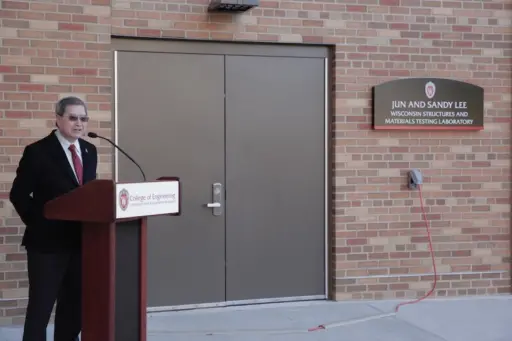A big new structures lab, formally opened this week, represents a leap forward for the University of Wisconsin-Madison’s structural engineering program. The College of Engineering held an official opening ceremony for the Jun and Sandy Lee Wisconsin Structures and Materials Testing Laboratory on October 23, 2019.
The lab will serve the structural engineering program, which is a part of the college’s Department of Civil and Environmental Engineering. College of Engineering Dean Ian Robertson said the new facility—a 2,500 square-foot addition to the structures lab in Engineering Hall—will ensure UW-Madison continues its long history as a leader in the structural engineering field.
“This will be a new era for our structural engineering program here at UW-Madison,” says Robertson. “If you look back through the history of the College of Engineering, you will find that we’ve been conducting pioneering structural engineering research on our campus for more than 100 years. With this new facility and our faculty, we anticipate you’ll be hearing about new advances in the field of structural engineering coming from the department of Civil and Environmental Engineering.”
 College of Engineering alumnus Jun Lee speaks during the opening ceremony for the new Jun and Sandy Lee Wisconsin Structures and Materials Testing Laboratory. Photo: Alex Holloway.
College of Engineering alumnus Jun Lee speaks during the opening ceremony for the new Jun and Sandy Lee Wisconsin Structures and Materials Testing Laboratory. Photo: Alex Holloway.
The new structures lab cost roughly $3.2 million. It came to fruition through gifts from CEE friends and alumni, including a $1 million lead donation from Jun (BSCE ’68, MSCE ’69, PhDCE ’73) and Sandy Lee (BA ’69).
Jun Lee, president of the SRI Design, Inc. engineering firm, often tells students, coworkers and engineers who work under him that it’s vital for structural engineers to visualize what they’re doing—beyond simply knowing formulas or theoretical knowledge of how a structure should perform under certain conditions.
“This lab will provide for that kind of visualization, which is very important for students,” he says.
Gustavo Parra-Montesinos, the C.K. Wang Professor of Structural Engineering and structures lab director, notes the new lab will greatly improve the college’s ability to carry out full-scale testing. The old lab, which opened in 1984 and will remain in use as part of the new larger facility, was sometimes limited due to space constraints.
The new lab includes an L-shaped concrete post-tensioned reaction wall that is 26 feet tall with 10 feet deep buttresses, and a 6 ½-feet-thick post-tensioned strong floor. The wall and floor are lined with gridded high-strength anchor points, which are used to connect test specimens and fixtures such as hydraulic actuators for application of a wide variety of forces and displacements.
The lab also has a 20-ton overhead crane and opens up to allow access to the outside and the old lab, and enough space to test specimens as long as 40 feet.
Parra-Montesinos says the extra space and greatly bolstered capabilities—the 20-ton crane has a loading capacity double that of the old lab’s crane—will make a big difference for students.
“They will be able to really feel how structures behave,” Parra-Montesinos says. “Sometimes we show them photos or videos, but it’s never the same as witnessing a structural member failing, for example—having that true experience.
“That will position them among the best in the nation, not only in terms of structural design, but for things like forensic engineering—how to understand what happened when a failure occurs, how to interpret cracks and skills such as that.”
Hannah Blum, an assistant professor who specializes in structural engineering, said the new lab’s larger floor allows for full-size model testing, while its height will let engineers test multi-story structures.
“You can create and run models, but how do you know if the model results are correct if you don’t have some initial test results to compare them against?” Blum says. “To really understand what’s happening in a structure and how all the elements interact together, you need to do a large-scale test.”
Lee says the lab addition puts the College of Engineering in prime position to conduct research that few other institutions can match.
“This is, if not the most capable, one of the most capable research labs in the entire United States,” he says. “It gives us an opportunity to do research projects that very few universities can do, which will deepen the knowledge of structural engineering beyond what we know now.”